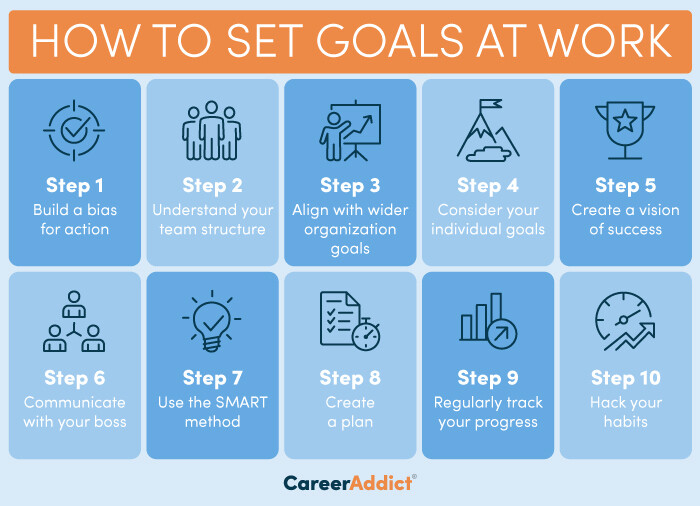Whether you’re just starting out in your career or you’re a seasoned professional, setting goals at work is vital to success. When done correctly, goal setting can provide you with clear direction, increased motivation, and higher productivity. In turn, these can all accelerate your career advancement and grow your confidence.
But setting goals at work differs from setting personal goals in some key ways — and requires a different approach. In this guide, we break down the most important steps in setting goals at work so you can get that promotion, receive a raise, or just feel a sense of professional achievement.

Step 1: Build a bias for action
For many, the hardest part of setting and achieving goals at work is simply getting started. Our brains are skilled at coming up with a million reasons for why we shouldn’t even start. Fear of failure, not enough time, and hesitancy to get out of our comfort zones are reasons that many of us put off setting goals at work.
This is why developing a bias for action is an important first step in reaching your goals and increasing productivity. A bias for action refers to making decisions quickly without letting too much doubt or analysis get in the way. When it comes to setting and achieving goals at work, taking action is key, so try not to overthink your goals and just get that ball rolling.
Step 2: Understand your team structure
When setting goals at work, the next step is to understand how your professional goals fit inside the structure of your team. You wouldn’t want to set a goal only to discover later that the tasks involved actually fall within the remit of another team member. This could lead to not only workplace conflict but also inefficiencies and duplication of work.
However, understanding your team structure when setting goals at work can also enable you to decide if your professional goals could be shared with another member of your team. Goals don’t always have to be individual — and, sometimes, shared goals can make you more accountable and improve your teamwork skills.
Step 3: Align with wider organization goals
In order to get buy-in from your boss for your goals, you’re going to need to align them with the wider organization objectives. The more you can show how your professional goals also benefit and lead to the success of the company, the more support you will find.
Therefore, do some research on the current strategic objectives of your company. You can then figure out how your team and your specific areas of responsibility are aligned with those objectives — and set your own work goals accordingly.
Step 4: Consider your individual goals
But even though your goals will need to be aligned with the organization, you should still make sure they align with your professional development plan, or personal career goals as well. Each goal, whether small or large, should ideally help you develop professionally and set you on track to reaching your those goals.
For example, say the current objective of the company is to expand to a new market. In the marketing team that you work in, the current goal is to increase website traffic for that specific market. However, there is a myriad of strategies to increase website traffic, including UX, design, copywriting and digital ads.
So, be deliberate in choosing a goal and the tasks it will entail. After all, motivation is a key factor in achieving goals — so you want to make sure you are developing in areas that align with your career goals.
Step 5: Create a vision of success
Stephen R Covey, author of The 7 Habits of Highly Effective People (paid link), advises that when setting goals, we should “begin with the end in mind”. In other words, envision what success looks like for you and visualize the ultimate destination. These visualization techniques in the pursuit of goals have even been proven in various studies to be effective.
To get the most benefit, try taking some time either once a day or once a week to imagine and visualize the attainment of your goals. Using visualization techniques are not only beneficial when setting your goal but can help you stay motivated throughout. Creating a clear vision of success will help you stay on the right path and not lose sight of your goal.
Step 6: Communicate with your boss
Before starting on the path to achieve your goals, a crucial step will involve talking to your boss about them.
This step is important for a few different reasons.
Firstly, although you may have an idea of the wider organization or team objectives, your boss may be able to provide more clarity on them. You’ll also most likely require their approval, particularly if the goals differ in any way from your standard tasks.
The second reason it is important to communicate your goals with your boss is so that they can hold you accountable and be a source of support. Showing your boss that you can set and achieve goals will be an extra motivation boost. And they will most likely want to help by providing advice, moral support, or resources.
Step 7: Use the SMART method
The SMART goals method is a widely used framework that can increase the likelihood that you will achieve your goals. SMART is an acronym that contains the characteristics of an ideal goal.
Below are some questions you can ask yourself to ensure your goal meets the SMART criteria:
- Specific: Is your goal in narrow and clear terms?
- Measurable: Do you have data or metrics to evaluate the success of your goal?
- Attainable: Is your goal possible, and do you have everything you need to reach it?
- Relevant: Is your goal aligned to your individual and company goals?
- Timely: Do you have a deadline or end-date?
Let’s take, for example, two goal statements: “I will increase website traffic” and “I will increase the amount of unique website visitors 20% by December 2022”. Now which goal do you think is more likely to be achieved? By using the SMART method, you can be sure you’re setting achievable career goals.
Step 8: Create a plan
Benjamin Franklin famously said: “If you fail to plan, you are planning to fail”.
So, in order to best set yourself up for success, you’re going to need a plan. With your SMART goals as the cornerstone of your plan, you’ll want to break the goals up into smaller action steps. This will not only give you a sense of achievement along the way but also help to keep you on track.
When creating a plan, be sure to not only verbalize it but also write it down. One study showed that goal setters who wrote down their goals and plan of action were 33% more likely to achieve them than those with unwritten goals.
So, for better chances of success, make sure to not only verbalize your plan but also create a physical copy of it.
Step 9: Regularly track your progress
Setting a SMART goal and creating a plan are two methods that will help ensure success before you begin working towards your goal. However, make sure you don’t just file your plan away into a dark corner of your computer. It’s important to continuously review your plan and track your progress so that your goal doesn’t fall to the wayside.
Set a time aside at regular intervals to track your progress. Regularly checking how you’re progressing with your goals will enable you to course-correct or make improvements if needed. If there are any blockers on the way to achieving your goals, it’s always better to find out sooner than later.
Step 10: Hack your habits
Most goals are attained through repetitive and consistent behaviors or tasks done over a specific period of time — otherwise known as habits. For many of us, forming and sticking with habits can be tricky. But there are certain hacks that make it easier to incorporate small habits into your regular routine.
One example of a habit hack is what is known as habit stacking. This essentially involves pairing something you already do daily with another task that will help you achieve your goal.
For example, say your goal is to win a new client by the end of the quarter. One way you can use habit stacking is to spend one hour after each Monday team meeting prospecting potential clients. Your brain will then link the two activities together, and it will be easier to stay consistent and reach your goal.
Key takeaways
Being able to effectively set goals at work is a skill that can alter the trajectory of your career. You’ll not only gain a reputation as a competent, accomplished professional, but you’ll also develop higher self-efficacy and confidence in the process.
To wrap things up, these are the top three takeaways to remember:
- Strategically align goals to the organization, team, and your wider career objectives.
- Create a detailed plan using SMART goals as the basis.
- Work on building better habits to reach your goals.
By following the 10 steps outlined above, you’re well on your way to setting — and smashing — your work goals!
Got a question about setting goals at work, or want to share your own tips? Let us know in the comments section.
Originally published in February 2015.

